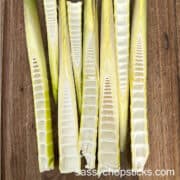A wok is a versatile cooking tool used in Asian cuisine for centuries. This round-bottomed cooking pan has high sides that make it suitable for boiling, steaming, deep-frying, and stir-frying. One great advantage of this cookware is that it allows you to cook food evenly and quickly without hot spots. It’s an excellent choice for those who want to cook healthy meals because it requires less oil than traditional frying pans.

Jump To
There are two popular varieties of woks available on the market. These include cast iron and carbon steel. Cast iron vs carbon steel wok? Both have their set of advantages and considerations. To make an informed decision, it is important to compare them.
What is cast iron wok?
Cast iron woks are a smart option, and they have been used for centuries because of their unique properties. The heavy material used enhances the durability of this cookware and improves its heat retention. Cast iron woks are very versatile. You can use them for deep frying, stir-frying, and even baking.

It is a variation of the traditional Chinese wok, typically made from carbon steel or stainless steel.
Cast iron woks have several distinctive features. They are typically deeper and have a round bottom, allowing for easy tossing and flipping of ingredients during stir-frying. The cast iron construction provides excellent heat retention and distribution, essential for achieving the high temperatures required for stir-frying. The heavy weight of cast iron also helps to maintain steady heat and prevents hot spots.
Overall, a cast iron wok is a versatile and durable cooking tool ideal for high-heat cooking techniques such as stir-frying, deep-frying, and searing. Many chefs and home cooks favor its excellent heat retention and ability to create delicious stir-fried dishes.
Advantages
- Ideal for searing and cooking at higher temperatures: A cast iron wok is a cooking utensil made from cast iron explicitly designed for stir-frying and other high-heat cooking methods.
- Long-lasting and durable: using a cast iron wok is its durability and ability to withstand high temperatures. It can be heated to high temperatures without warping or losing shape. Cast iron also develops a natural non-stick surface over time as it is seasoned with oil and used repeatedly.
- Excellent heat distribution and retention
- Can be used on all types of stovetops, including induction stoves
- Very versatile
- Adds iron to your diet
- Can go from stovetop to oven for added convenience
Considerations
- Bulky, heavy size: cast iron woks can be pretty heavy, making them somewhat difficult to handle and maneuver compared to other wok materials. They also require regular seasoning and proper maintenance to prevent rusting and maintain their non-stick properties.
- Slow to heat up
- Prone to rusting if not properly cared for
- Can be challenging to maintain and requires seasoning
What is carbon steel wok?
A carbon steel wok is a cooking utensil from carbon steel commonly used in Chinese and Asian cuisine. It is a popular alternative to cast iron woks due to its lightweight nature and excellent heat conductivity. It is

popular for their easy handling and lightweight design properties. Carbon steel pans and woks heat up quickly and are very versatile. You can use them for sautéing, searing, and stir-frying.
Carbon steel woks have several distinguishing features. They typically have a round bottom and sloping sides, which make it easy to stir and toss ingredients during cooking. The sloping sides also help to contain the food within the wok while allowing for efficient heat distribution.
One of the main advantages of using a carbon steel wok is its quick and even heating. Carbon steel is a good conductor of heat, allowing the wok to heat up rapidly and maintain a consistent temperature throughout the cooking process. This feature is crucial for achieving the desired "wok hei," which refers to the smoky, seared flavor imparted to the food when stir-fried at high heat.
Carbon steel woks are also relatively lightweight compared to cast iron woks, making them easier to handle and maneuver. They heat up faster than cast iron and are more responsive to changes in temperature, allowing for precise control over the cooking process.
Like cast iron, carbon steel woks require seasoning to develop a natural non-stick surface. Seasoning involves applying a thin layer of oil and heating it to create a protective coating. This process enhances the wok's non-stick properties, prevents rusting, and adds flavor to the cooked food.
Notably, carbon steel woks require regular maintenance to prevent rusting and maintain their seasoning. They should be thoroughly dried after each use and occasionally re-seasoned to keep their non-stick surface.
In summary, a carbon steel wok is a versatile and popular cooking tool known for its lightweight construction, excellent heat conductivity, and ability to achieve the coveted "wok hei" flavor. It is widely used in stir-frying, deep-frying, and other high-heat cooking techniques in Asian cuisine.
Advantages
- Lightweight and easy to handle
- Quick and even heat distribution
- Can be used on all types of stovetops, induction stoves
- Requires minimal maintenance
- Very versatile
- Adds a subtle flavor to the food
Considerations
- Less durable and requires careful handling
- Can be reactive with acidic foods and ingredients
- Requires seasoning and regular cleaning to prevent rusting
- Cannot be used in the oven
Cast iron vs Carbon steel wok – differences
There are several key differences between cast iron woks and carbon steel woks. The following are the key differentiating factors:
Design
Cast iron skillets feature a round shape with a flat bottom and high sides. Carbon steel woks have a similar design but with one main difference: they feature a slightly curved, round base. Both types of woks feature a wooden handle for easy, safe handling.
Materials
Cast iron woks feature heavy-duty cast iron material, while carbon steel woks feature lighter and thinner carbon steel material. Cast iron is well-known for its heat retention ability, while carbon steel boasts a quick heat-up time.
Performance (Heat Distribution, Retention)
Both cast iron and carbon steel woks are very versatile. Cast iron flat bottom woks have excellent heat retention properties, which makes them a good choice for high heat cooking. On the other hand, carbon steel woks distribute a lot of heat more quickly, making them a better option for quick-cooking dishes, sautéing and stir-frying.
Ease of Use
While both cast iron and carbon steel woks require a seasoning process, carbon steel woks are relatively easier to season during the cooking process thanks to their thinner and lightweight material. Cast iron woks require extra care and maintenance to prevent rusting.
Nonstick Coating
When properly seasoned, cast iron woks have excellent non-stick surface properties, which make them suitable for cooking with less oil. Carbon steel woks, on the other hand, typically require a bit more vegetable oil to prevent food particles from sticking to their surface area.
Size And Weight
Compared to carbon steel woks, cast iron woks are bulkier and heavier. This makes them difficult to maneuver when wok cooking. Carbon steel woks, on the other hand, are easier to handle because they are lighter and thinner.
Portability
Carbon steel woks feature a compact size, and they are very lightweight. These properties make this carbon steel cookware more portable than cast iron woks, which feature a bulky design.
Cleaning and Maintenance
Although cast iron and carbon steel woks require regular cleaning and maintenance to keep them in good condition, cast iron needs more regular, proper care to prevent rust. Carbon steel woks are less prone to rust and require minimal maintenance. Cast iron requires regular maintenance to avoid rust and to maintain the seasoning. Remember to dry thoroughly after each use.
Seasoning
You should season cast iron woks with oil to create a natural non-stick surface and protect against rust. Carbon steel woks must be seasoned like cast iron to develop a natural non-stick surface and prevent rust.
Cast iron vs Carbon steel wok– which is better?
In summary, cast iron vs carbon steel wok? The main differences between cast iron woks and carbon steel woks lie in their weight, heat retention, heat distribution, and maintenance requirements. Cast iron woks are heavier, have better heat retention, and may require more attention to even heat distribution. Carbon steel woks are lighter, have excellent heat conductivity and distribution, and are generally easier to handle. Both types of woks are highly durable and require seasoning and regular maintenance to maintain their non-stick properties and prevent rust. The choice between the two depends on personal preference and cooking style.
Both cast iron and carbon steel woks have unique pros and cons and are great additions to a Chinese kitchen. There is no best wok because no one option is objectively better than the other. Ultimately, the right wok for you is the one that suits your specific kind of cooking and personal preference. Please look at their key differences and choose what works best for you.

















Leave a Reply